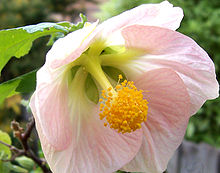- Connation
-
Connation in plants is the developmental fusion of organs of the same type, for example, petals to one another to form a tubular corolla.[1][2] This is in contrast to adnation, the fusion of dissimilar organs.
 The stamens of this Hibiscus are synfilamentous
The stamens of this Hibiscus are synfilamentous
Terms for connation of flower parts
- Synsepalous: All the sepals of a flower are fused into a cup or tube, the fused portion is the calyx tube and any non fused tips are the calyx lobes.
- Sympetalous: All the petals of a flower are fused into a cup, tube, or other shape.
- Stamens:
- Synandrous: Stamens are fused in an unspecified manner
- Synfilamentous: Stamens are fused by their filaments
- Synantherous: Stamens are fused by their anthers
- Syncarpous: Carpels are fused together to form a compound ovary
The corresponding terms for parts that are free (not connate) begin with the prefix "apo-". An apopetalous corolla has free, unfused petals.
References
- ^ Little, R. John; Jones, C. Eugene, eds (1980). A Dictionary of Botany. New York: Van Nostrand Reinhold Company. p. 91. ISBN 0442241690.
- ^ Jackson, Benjamin Daydon (1928). A Glossary of Botanic Terms with their Derivation and Accent (fourth ed.). London: Gerald Duckworth & Co. Ltd.. p. 89. http://www.archive.org/details/glossaryofbotani1928jack.

This botany article is a stub. You can help Wikipedia by expanding it.
